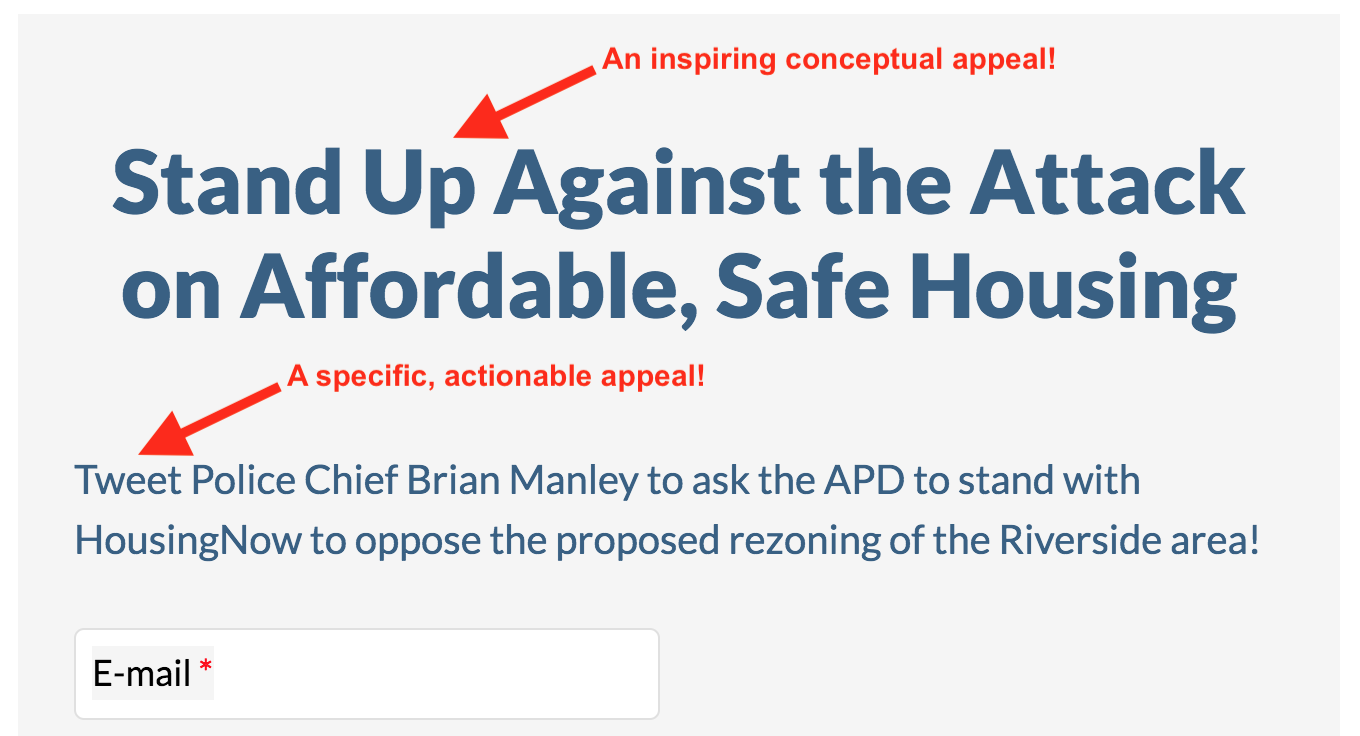A supporter lands on your campaign page. They’re interested. But this is the age of scanning, swiping, and smart phone attention spans. On New/Mode campaign tools, your message to supporters is front and center. The key to a successful action is now converting a supporter’s interest into concrete, quantifiable participation.
There are six key principles for writing a powerful, persuasive Call to Action (CTA):
- Activate, Don’t Educate
- Guide Supporters on How to Take Action
- Don’t Split the Ask
- Less is More
- Connect With Your Audience
- Location! Location! Location!
Activate, Don’t Educate
Your campaign agenda is backed up by loads of data, and valuable information that your supporters need to know. But the campaign tool form is not the place to educate. Detailed research supporting your position can be included elsewhere on your landing page, or on a separate, easily accessible page on your website. You can even link to a deeper level of detail on the issues through your tool form, but your CTA has one purpose and one purpose only:
Guide Supporters on How to Take Action
You want people to “get involved,” “show support,” and “do their part,” but this type of language can be too vague for a CTA. Do you want them to sign a petition? Donate money? Tell their friends about your campaign?
Use present-tense action verbs that clearly tell your supporters what you want them to do and how they can do it right now. Some examples of present-tense action verbs related to New/Mode campaign tools include:
- Click the button...
- Make the call...
- Call your rep now...
- Contact your Senator...
- Send a Tweet...
- Tweet your MP...
- Sign this petition...
- Send this email...
- Send your message...
- Click to email the Mayor...
- Add your voice now...
- Write a letter...
- Share your story...
- Tell your union...
- Don’t wait...
With specific action verbs like these, your CTA can transition between a conceptual appeal (“Show your support”) and a direct, executable action (“Tweet your MP”). Aim for sentence structures that make this transition: “Show your support for stricter pipeline legislation by tweeting your MP now!”
Don’t Split the Ask
In your CTA, combine the use of direct, actionable language with a single, accomplishable goal. Avoid using a CTA to ask supporters to both write a letter AND make a donation. Instead, ease them into the process of political participation by beginning with a small ask, like signing a petition.
Once a supporter has taken the first step, you can then make an additional ask. All New/Mode tools automatically include Thank You Pages and Thank You Emails where you can encourage supporters to take that next step.
Less is More
How would you summarize your campaign message in one sentence? Your CTA needs to be simple, direct, and compelling. If that sounds complicated, try writing out three types of statements in response to these questions:
- What is the PROBLEM that your campaign is addressing?
- What is the GOAL of your campaign?
- Why should supporters CARE?
Use your responses to these questions to craft an action-focused message that clearly highlights the sharp edge of the problem and tells supporters why acting will have an impact.
Your CTA doesn’t have to be crammed into one long sentence, but try to keep it to two or three lines of text as seen live on your campaign tool. Anything more will read as too much text, particularly on mobile devices!
Connect With Your Audience
As you craft your CTA, keep in mind that this message is for your supporters, not for the targets of your action. Content addressed to targeted decision-makers can go under Key Points, and in the body of the message being sent by your supporters.
Use language that will be accessible both to new supporters, and to already-contributing community members. Consider these questions:
- Is the issue at hand serious or celebratory? Rage-inducing or inspirational?
- Is your timeline urgent or directed toward long-term goals?
- Are you trying to build numbers or cultivate active supporters?
As you tailor the tone and content of your CTA to your support base, remember to also bring it in line with the nature of the campaign.
Do you know your demographics? Use our Know Your Audience quiz to find out!
Location! Location! Location!
By default, CTAs on a New/Mode campaign tool are at the top of the tool form, front and center, but there are a few other key issues relating to CTA placement that you need to consider:
- The relationship of your CTA to the title of your campaign tool: On New/Mode tools, the CTA goes directly below the tool title, so it may be offering the next layer of detail that your supporters need after that informative title explains the key issue.

- The relationship of your CTA to the action button: Be sure to use language in your CTA that repeats the label on the action button (i.e. ‘Take Action,’ ‘Make the Call,’ ‘Add Your Voice’). Also consider the distance on the page between your message and the button. Ideally, that big, friendly action button should be visible when supporters are reading your CTA.
- The placement of your tool form on the webpage: You can choose to have a campaign tool take up an entire page, or have it fill half the page on the right or left side, or fit into a corner of the page as a smaller form. Whatever you choose, consider how the information on the rest of the page will interact with your CTA.
Feeling ready to craft that simple but powerful, fierce but functional call to action? Let’s get started, and keep in mind that New/Mode tools can be edited live, so you can always come back to edit and revise your tool content as your campaign develops!
